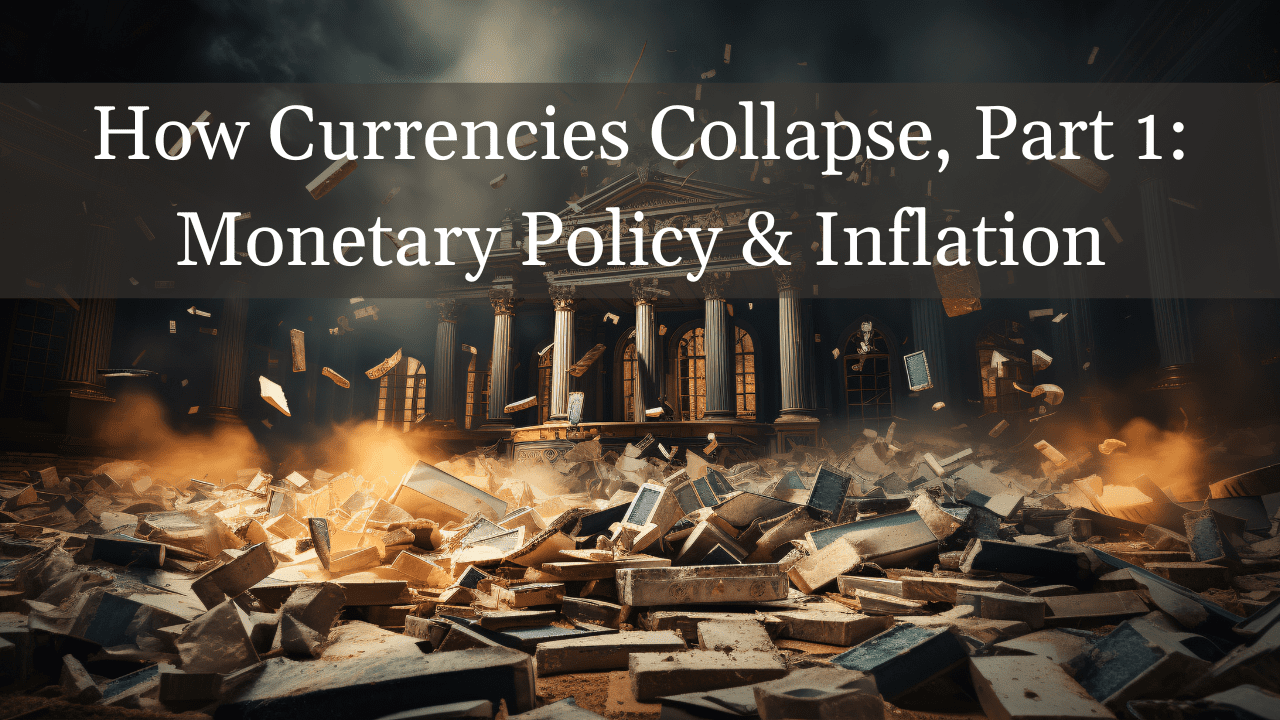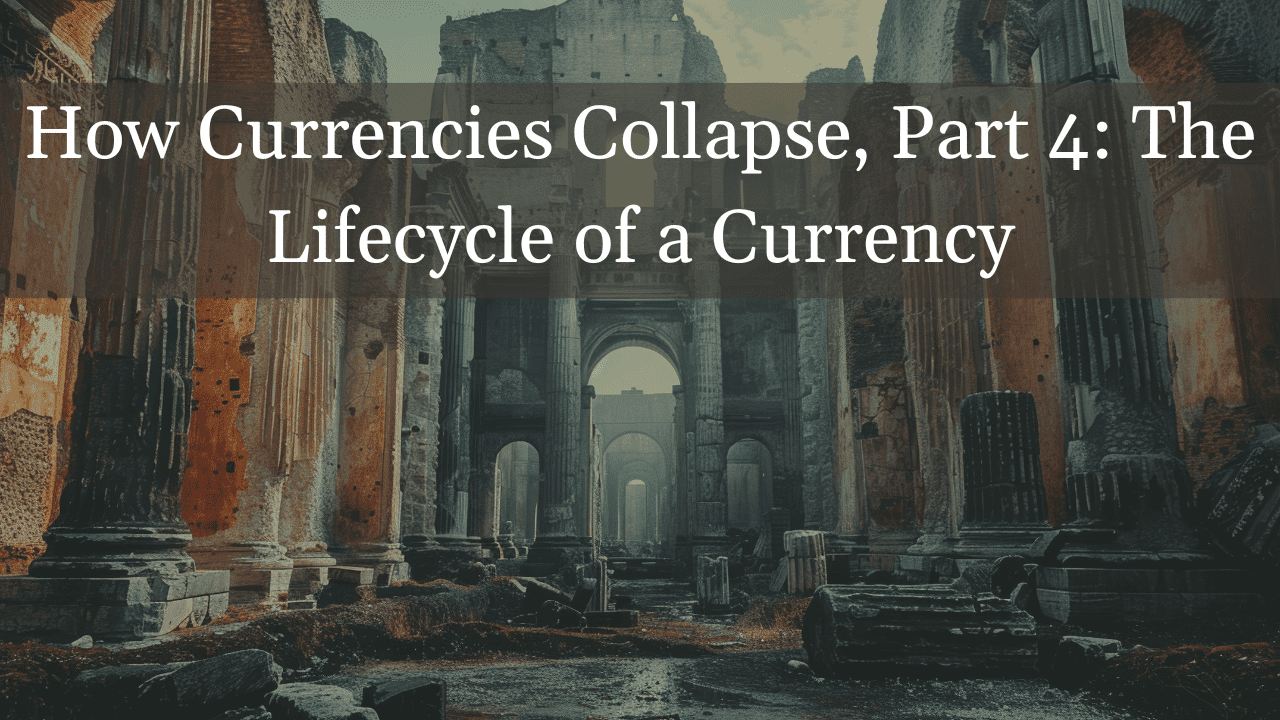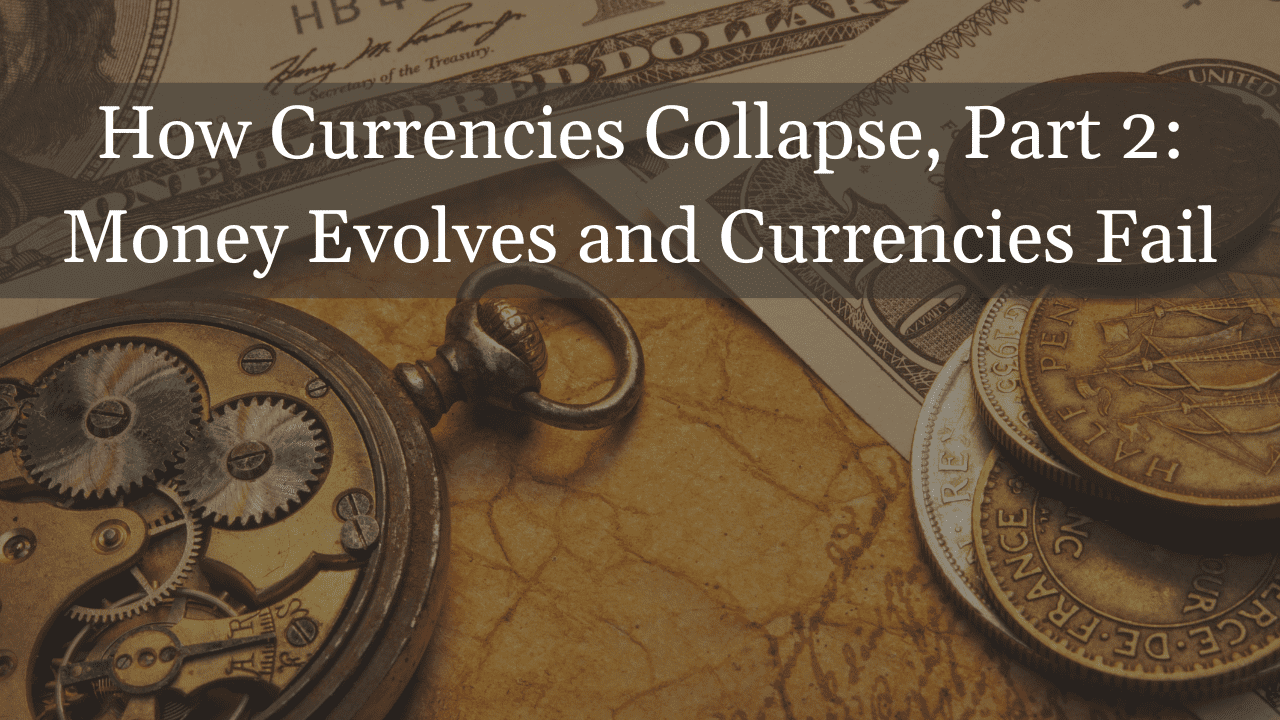How Currencies Collapse, Part 1: Monetary Policy & Inflation

Introduction
First, let me thank the folks at ITM for giving me a platform to write about things I already love writing about. For over 25 years, I’ve been exploring the interrelationships of politics, economics, monetary policy, how currencies collapse, financial markets, natural resources (particularly precious metals), and technology.
Using my past experience as a prism through which to view the present, my goal is to bring readers an ongoing series of articles that are always informative, sometimes provocative, and generally entertaining.
A tall order, so let’s dive right into one of the least entertaining subjects in all the world: inflation and how currencies collapse.
Is there anyone out there who hasn’t been touched, if not infuriated, by the inflation of the past few years? Anyone who hasn’t said, please, could we just go back to the way things were in 2019?
Didn’t think so.
How bad has it been? Let’s just take food. Not long ago that it was impossible for me, a single person, to spend $100 at the grocery store. Now it’s hard not to. Since the beginning of 2020, according to data from the St. Louis Fed, the price of bread is up 48%; a dozen eggs are up 105%; boneless chicken breasts are up 34%. And so on. Let’s not even get into the price of a home or a car (or insuring one).
We haven’t seen anything like this since the 1970s. It hurts. Understandably, people want to know why damaging episodes like this happen, and what might come next.
You’ve probably seen any number of explanations. Pandemic-induced supply chain issues says one analyst. Runaway corporate greed says another. It’s an inevitable byproduct of capitalism, says a third.
The truth is that it’s complicated, and a deep examination of the subject would occupy many times the amount of space I have here—and take us afield from the topic of currency collapses. So let me simplify, and place inflation in that context.
The Relationship Between Monetary and Price Inflation
Before we can address the general problem, and find a common denominator, we have to define our terms. In common parlance, the dreaded I-word is used to denote an uncomfortable rise in the prices of goods and services, or price inflation. However, it originally meant an unwarranted increase in the money supply, or monetary inflation. The two are different phenomena, but as intimately related as sun and shadow.
Famed economist Milton Friedman put it this way: “Inflation is always and everywhere a monetary phenomenon in the sense that it is and can be produced only by a more rapid increase in the quantity of money than in output.”
That is one of the core principles under which a free market operates. Every society has a supply of goods and services, and a demand for them. Buyers have to earn enough to purchase what they need (or want). Sellers have to realize enough in return to make it profitable to continue producing. It’s an eternal dance.
The mediator between the two is money. So that if I had to have a camel, I didn’t have to come up with six lambs and a sheaf of wheat to swap for it. But what we don’t want is for too much money to be chasing the same amount of goods and services. That drives up the price of everything.
Real money, in the form of metal coinage, was invented in the kingdom of Lydia (part of modern Turkey), in the 7th century BCE, and the concept spread like a modern meme. Ok, not that quickly, but … really fast for an ancient world which wouldn’t have electronics for more than 2,500 years.
The Origins of Money and Inflation
The adoption of money as a medium of exchange made for an explosive growth in trade among and between settled human groups. Problem is, it came with a surly sidekick. Inflation. Yep, pretty much from the beginning. By design.
If we were to have money, then someone had to issue it. There was a lot of experimentation in this area over millennia, but it usually came down to the king or whoever the central government happened to be. In order for remote buyers to trust money, they had to believe in the authority that stood behind it and guaranteed its value. (Note: the words money and currency have become synonymous. They aren’t, but I’ll use them as such for now, and leave spelling out the distinction for a future post.)
In reality, of course, even if you have a monopoly on the coinage of money, you can still run short of it. In times of war, for example. You have to pay the troops even if your stash is running low. So many an ancient ruler did what we’d all probably do if our heads were on the line. They cheated.
You cheat by debasing a coin, in a couple of ways. You can make it smaller but with the same face value. Or you can replace a portion of the precious metal content with a cheaper metal. In either case, you’re issuing more money from your same stock of metals (gold, silver, copper).
Voilà, the birth of monetary inflation.
That’s how the Roman emperors did it, and they went all-in. After a century or two of adulteration, their “silver” coins no longer contained any silver. People noticed. The “same” amount of money was buying less and less. Over time, trust, the essential ingredient in any monetary system, disappeared.
The currency collapsed.
Some historians attribute the fall of Rome to the debasement of its currency more than any other factor.
Modern Monetary Inflation and Government Spending
Fast forward a couple of millennia, and that’s still how it’s done. With considerably more sophistication, of course, but the grift is mainly the same. When governments can’t afford their expenses, they create currency that they don’t have to pay the bills. Romans shaved their coins; central banks just add extra zeroes to their accounts. (If you or I did this, it’d be called counterfeiting and we’d be jailed.)
Often they’ll do it for the “common good.” During Covid, Washington first shut down the economy, then tried to “compensate” us. In just one year—March 2020 to March 2021—we all got massive “relief”: $2.2 trillion was distributed through the CARES Act (you gotta love their acronyms); $920 billion through the Consolidate Appropriations Bill; and $1.9 trillion through the American Rescue Plan. This led monetary inflation to previously-unexplored heights. (For comparison purposes, we spent $1/2 trillion less to win WWII.) The Fed also chipped in with a round of Quantitative Easing, adding some $4 trillion to its balance sheet, but that’s a complex story for another day.
All that monetary inflation will eventually produce price inflation, which you’ve noticed.
Here’s the really crucial point I want to make. You see inflation in the grocery store and you probably think that prices are, for some reason, spiraling out of control. You curse the bread maker. But once you understand the effects of monetary inflation, the real issue is evident. It’s not that the price of bread is going up, it’s that your purchasing power is declining. The value of your dollar is going down.
This cannot be over-emphasized.
The Importance of Sound Monetary Policy to Prevent a Currency Collapse
Milton Friedman one more time: “A steady rate of monetary growth at a moderate level can provide a framework under which a country can have little inflation and much growth.”
He’s right. Inflation is not a “normal” aspect of our economic system. Though few realize it, there was net zero inflation for the entire 19th century in the U.S. At the beginning of the 20th century, the dollar was actually stronger than it had been a hundred years earlier! True story.
Inflation can be held in check by a sound monetary policy. Once it gets out of control, though, it can lead to hyperinflation. And that has historically led to currency collapses. Weimar Germany and Zimbabwe are obvious examples.
Can it happen here? Sure; we have some safeguards, but they’re not ironclad. The current path doesn’t look good. The reason people protect their wealth and portfolios with gold and silver is “just in case”.
Conclusion
What I do know is that an unsound monetary policy will eventually yield consequences far worse than the high price of bread, including the heightened possibility of a currency collapse.
That’s a future we may face.
I invite you to return for the next installment in this series, where I’ll clarify the distinction between ‘money’ and ‘currency,’ and dig more deeply into how and why currencies collapse. Stay tuned.
By Doug Hornig
Contributing Author, ITM Trading
www.itmtrading.com
P.S. Schedule your free consultation to learn how inflation and unsound monetary policies could lead to currencies collapsing, jeopardizing your financial future. For 28+ years we’ve helped thousands discover how to protect their wealth and retirement. Call 866-953-7929 or click here to schedule your consultation now.









